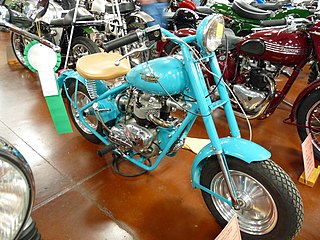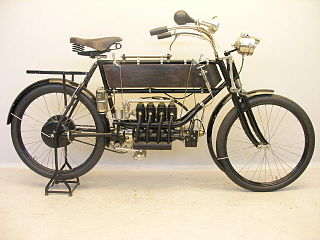
Harley-Davidson, Inc. (H-D), or Harley, is an American motorcycle manufacturer, founded in Milwaukee, Wisconsin in 1903.
Indian is an American brand of motorcycles originally produced from 1901 to 1953 in Springfield, Massachusetts, United States. Hendee Manufacturing Company initially produced the motorcycles, but the name was changed to the Indian Motocycle Manufacturing Company in 1928.

The Norton Motorcycle Company is a British motorcycle marque, originally from Birmingham, England, UK. It was founded in 1898 as a manufacturer of "fittings and parts for the two-wheel trade". By 1902 the company had begun manufacturing motorcycles with bought-in engines. In 1908 a Norton-built engine was added to the range. This began a long series of production of single and eventually twin-cylinder motorcycles, and a long history of racing involvement.

Singer Motors Limited was a British motor vehicle manufacturing business, originally a bicycle manufacturer founded as Singer & Co by George Singer, in 1874 in Coventry, England. Singer & Co's bicycle manufacture continued. From 1901 George Singer's Singer Motor Co made cars and commercial vehicles.
The Scott Motorcycle Company was owned by Scott Motors (Saltaire) Limited, Shipley, West Yorkshire, England and was a well-known producer of motorcycles and light engines for industry. Founded by Alfred Angas Scott in 1908 as the Scott Engineering Company in Bradford, Yorkshire, Scott motorcycles were produced until 1978.
Phelon & Moore manufactured motorcycles in Cleckheaton, Yorkshire, England from 1904 to 1967 particularly those under the Panther marque. They became identified with one particular design of motorcycle which had a large sloping 40-degree single-cylinder engine as a stressed member of the frame. This design spanned the entire history of the company, starting with a 500 cc model and ending with a 645 cc model.
The Calthorpe Motor Company based in Bordesley Green, Birmingham, England made a range of cars, motorcycles and bicycles from 1904 to 1932.
Henderson was a manufacturer of 4-cylinder motorcycles from 1912 until 1931. They were the largest and fastest motorcycles of their time, and appealed to sport riders and police departments. Police favored them for traffic patrol because they were faster than anything else on the roads. The company began during the golden age of motorcycling, and ended during the Great Depression.

The Ner-A-Car was a type of feet forwards motorcycle designed by Carl Neracher in 1918. It used an unusual steel-channel chassis, much like an automobile, and hub-center steering at the front wheel, making it 'nearly a car' in design. The Ner-A-Car was the most successful hub-center steering motorcycle ever produced, with sales far eclipsing earlier or later examples of this design, such as the Yamaha GTS1000 or Bimota Tesi. About 10,000 Neracars were manufactured in the United States by the Ner-A-Car Corporation, while around 6,500 are believed to have been produced in England under licence by the Sheffield-Simplex company between 1921 and 1926 under the Ner-A-Car name.

Douglas was a British motorcycle manufacturer from 1907–1957 based in Kingswood, Bristol, owned by the Douglas family, and especially known for its horizontally opposed twin cylinder engined bikes and as manufacturers of speedway machines. The company also built a range of cars between 1913 and 1922.

The Mustang was a lightweight motorcycle built by Gladden Products Corporation in Glendale, California, from 1946 to 1965. The second production version, the Mustang Model 2, was the first motorcycle manufactured in the United States to have a telescopic fork.
The history of the motorcycle begins in the second half of the 19th century. Motorcycles are descended from the "safety bicycle," a bicycle with front and rear wheels of the same size and a pedal crank mechanism to drive the rear wheel. Despite some early landmarks in its development, the motorcycle lacks a rigid pedigree that can be traced back to a single idea or machine. Instead, the idea seems to have occurred to numerous engineers and inventors around Europe at around the same time.
The Green Engine Co was a British engine company founded by Gustavus Green in Bexhill to sell engines of his design. He flourished especially as a designer of aeroplane engines during the first two decades of the 20th century. The engines were actually manufactured by the Aster Engineering Company.

Bradbury Motor Cycles was a British motorcycle manufacturer based in Oldham, England and established in 1902. Originally involved in the manufacture of machine tools, sewing machines and cycles, their first motorcycles were bicycles with clip-on Minerva engines. The Bradbury factory went on to develop and produce a range of single-cylinder motorcycle, V-twins and horizontally opposed twins. The 1912 Bradbury motorcycles were one of the earliest with variable gearing. Although the factory survived the First World War it closed in 1924.

The Indian Scout is a motorcycle built by the Indian Motocycle Company from 1920 to 1949. It rivaled the Chief as Indian's most important model. The 101 Scout, made from 1928 to 1931, has been called the best motorcycle Indian ever made. A second line of Scouts, with heavier frames, was introduced in 1932 alongside the Standard Scout, which replaced the 101 Scout and shared its frame with the Chief and the Four. The small-displacement Scout and the Sport Scout, introduced in 1934, were continued until the end of civilian production in 1942. Military versions of both models were used by US and other Allied forces during World War II.

The Pierce Four was the first four-cylinder motorcycle produced in the United States. The model is included in the AMA Motorcycle Hall of Fame Classic Bikes and Barber Vintage Motorsports Museum. Touting its inline-four engine as "vibrationless", Pierce sold the motorcycle for $325, rising to $400 by 1913, which was expensive at the time, making it popular with "more prosperous sportsmen".

Charles Bayly Franklin was an engineer and a motorcycle racer. He is most notable for designing motorcycles for the Indian Motocycle Company, including the original Indian Scout of 1920, the original Indian Chief of 1922, and the Indian 101 Scout of 1928. Prior to this, he had been part of the Indian motorcycle team that won first, second, and third place in the 1911 Isle of Man TT, finishing in second place. Franklin was inducted into the AMA Motorcycle Hall of Fame in 2016.

The Cleveland Motorcycle Manufacturing Company, sometimes called Cleveland Motorcycle, was a motorcycle manufacturer in Cleveland, Ohio from 1902 to 1905 and again from 1915 to 1929.

The FN Four was the world's first production inline-4 motorcycle, manufactured in Liége by Fabrique Nationale from 1905 until 1923. It was also, at 40 miles per hour (64 km/h), the world's fastest production motorcycle from 1911 until 1912.

Flathead motorcycles are a type of bike that was a standard for pre-war motorcycles, in particular US V-twins such as Harley-Davidson and Indian, some British singles, BMW flat twins and Russian copies thereof.














